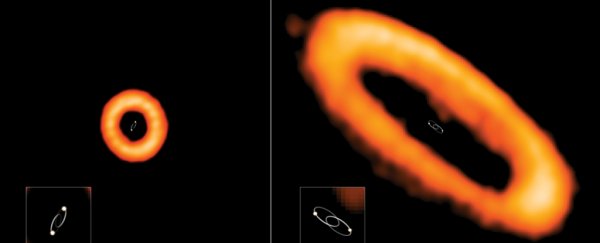There's an iconic scene in the original Star Wars movie where Luke Skywalker looks out over the desert landscape of Tatooine at the amazing spectacle of a double sunset.
Now, a new study out of the National Radio Astronomy Observatory (NRAO) suggests that such exotic exoplanet worlds orbiting multiple stars may exist in misaligned orbits, far out of the primary orbital plane.
The find has implications for planetary formation in complex multiple star systems. The study used ALMA (the Atacama Large Millimeter/submillimeter Array) in Chile to look at 19 protoplanetary disks around binary stars with longer period orbits, versus a dozen binary stars known to host exoplanets with periods less than 40 days found in the Kepler space telescope observations.
Planets are formed in protoplanetary disks surrounding young stars, as debris slowly coalesces into worlds. In the case of binary stars, these rings are known as circumbinary disks.
"The study provides needed context for interpreting the circumbinary planets that the Kepler mission found," Astronomer Ian Czekala of the University of California at Berkeley told Universe Today.
"By using independent data from radio observations of circumbinary protoplanetary disks out of which the circumbinary planets would form, we can now say something concrete about how many circumbinary planets form misaligned relative to their binary star planes."
The discovery of Kepler-16b, the first exoplanet orbiting a multiple star system was announced in 2011. As the number of exoplanet discoveries grows daily, we're starting to realize that complex systems found orbiting double and multiple stars have their own strange tales to tell.
What could occur in systems with more than two stars? "We have only a few samples of protoplanetary disks around triple or quadruple stars (such as) GW Orionis and GG Tauri," says Czekala.
"So there isn't enough data to say for certain. The dynamical environment for a triple system is more complex than that for a binary system, so my expectation is that you would see a greater prevalence of strange orbits."
Our placid Solar System is an oddball among main sequence stars: it's strange to think that a majority of the stars you can see with the naked eye tonight are doubles and multiple stars.
Here's another related bizarre fact: not a single red dwarf - the most common sort of star in the Universe - is close or bright enough to be seen from Earth with the naked eye.
Seeing double
The study found that the longer a binary pair's orbital period, the more likely its circumbinary debris disk is misaligned out of the orbital plane of the inner pair. The cut-off for alignment versus misalignment seems to be right around an orbital period of 40 days.
If the host pair is in a tight fast orbit, the circumbinary disk tends to stay in alignment… but a disk around a pair with a slower orbit tends to become misaligned over time.
 Misaligned HD 98800 b (left) with an orbital period of 315 days, and AK Scorpii (right) with a period of just 13.6 days. (ALMA, ESO/NAOJ/NRAO, I. Czekala, G. Kennedy and NRAO/AUI/NSF, S. Dagnello)
Misaligned HD 98800 b (left) with an orbital period of 315 days, and AK Scorpii (right) with a period of just 13.6 days. (ALMA, ESO/NAOJ/NRAO, I. Czekala, G. Kennedy and NRAO/AUI/NSF, S. Dagnello)
One limitation with the Kepler data is that it is looking at transiting exoplanets on very short period orbits, and short period exoplanets are much more likely to transit along our line of sight and turn up in the Kepler data in the first place.
It's more probable that planets orbiting binary stars with much longer periods simply haven't been seen yet, but may well turn up in future micro-lensing or direct imaging surveys.
The discovery shows just how different other planetary systems can be. In our own Solar System, we see the all of the major planets staying put along the plane of the ecliptic. But the orbital trek of a binary pair of suns can warp the outer circumbinary disk into the sort of misaligned orbits seen in the study.
One dramatic example is HD 98800 b (TV Crateris) located 150 light-years distant, a unique example of a circumbinary disk in a polar orbit announced by University of Warwick researchers in 2019.
Already, we're starting to add to the dataset of circumbinary planets. NASA's Transiting Exoplanet Survey Satellite (TESS) recently discovered its first exoplanet orbiting a double star, TOI (TESS Object of Interest) -1338b.
Exoplanet alien skies
The view and seasons from an exoplanet in a misaligned orbit would be equally eccentric.
For example, there would be times of the year where the observer on the surface of this alien world see the host stars as a wide distinct pair, while the two would merge and eclipse during 'plane-crossing season'… this would also change the amount of surface insolation received right around this time.
Right now, we're at 4,245 known exoplanets and counting. I'm old enough to remember a time before the final decade of the 20th century, when no exoplanets were known of beyond our solar system… and many prominent astronomers put forth good reasons to suggest that things would stay that way.
Fast-forward to 2020, and we now know of enough exoplanets to start classifying and characterizing other solar systems, in the true spirit of science and astronomy.
This article was originally published by Universe Today. Read the original article.
